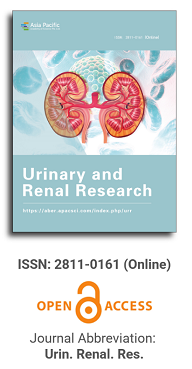
Asia Pacific Academy of Science Pte. Ltd. (APACSCI) specializes in international journal publishing. APACSCI adopts the open access publishing model and provides an important communication bridge for academic groups whose interest fields include engineering, technology, medicine, computer, mathematics, agriculture and forestry, and environment.
Renal clear cell sarcoma is the second most frequent malignant renal tumor in pediatric age, after Wilms' tumor. It is a difficult to diagnose neoplasm, with nonspecific clinical presentation as palpable abdominal mass, abdominal pain and hypertension and hematuria. The imaging characteristics of this lesion are non-specific, so its diagnosis is made by anatomopathological study of the tumor. Its importance revolves around the diagnostic difficulty, since this tumor presents great histologic variability and few adequate immunohistochemical markers. Treatment includes neoadjuvant and post-surgical chemotherapy, with a prognosis that improves if the disease is diagnosed early.
Enhanced recovery after surgery (ERAS) refers to the use of a series of specific evidence-based and proven effective measures during the perioperative period to enable quick recovery of patients. It can reduce the physiological and psychological pressure of patients, reduce the occurrence of postoperative complications, thereby shortening the hospital stay and reducing hospitalization costs. Percutaneous nephrolithotomy is the main method for the treatment of renal calculi and upper ureteral calculi. It is widely used in clinic because of its small trauma, high stone clearance rate, short postoperative recovery time and short hospital stay. This article reviews the current status of ERAS combined with percutaneous nephrolithotomy in urology and the role of ERAS in percutaneous nephrolithotomy.
Objective: To investigate the effect of RNA interference silencing of SOX9 (sex determining region Y-box 9) on the proliferation, apoptosis and tumorigenicity of renal cell carcinoma 786-O cells in vitro. Methods SOX9-specific small interfering RNA (small interfering RNA) , siRNA) sequence was the experimental silencing group, and the non-specific siRNA sequence was the control group and were transfected into 786-O cells respectively. The proliferation of 786-O cells was detected by CCK-8 assay and plate clone formation assay, and Hoechst 33342 cell staining was used to detect the proliferation of 786-O cells. Apoptosis of 786-O cells. The effect of RNA interference silencing SOX9 on tumorigenic ability of animals was detected by tumorigenic assay in nude mice. The expression of proliferating antigen Ki-67 protein was detected by immunohistochemistry. Compared with the control group, the OD value of the SOX9 silencing group was significantly lower, and the number of cell colonies was significantly lower than that of the control group, and the difference was statistically significant (P<0.05). Statistical significance (P<0.05). The results of animal tumorigenesis experiments showed that the volume and weight of the tumor in the SOX9 silencing group were significantly lower than those in the control group, and the difference was statistically significant (P<0.05). Immunohistochemical staining showed that the siRNA silencing group The proportion of Ki-67 positive cells was significantly lower than that in the control group, and the difference was statistically significant (P<0.05). Conclusion RNA interference silencing of SOX9 can significantly inhibit the proliferation of renal cell carcinoma 786-O cells, promote their apoptosis, and inhibit renal cell carcinoma 786-O cells. Cancer cell proliferation in nude mice.
Introduction: renal parenchymal tumors account for approximately 2-3% of tumors in adults' patients and in turn the 85% of primary kidney tumors. An increased incidence of renal parenchymal tumors has been observed around the world and in Cuba in the last years. It is the most deadly cancer in the urinary tract worldwide. Objective: to identify incidence and the clinical- epidemiological and histopathological features of renal cell carcinoma in the province of Santiago de Cuba. Method: a descriptive and cross-sectional study was conducted concerning renal adenocarcinoma in 88 patients from Santiago de Cuba. Period of study was from January 1, 2012 throughout January 1, 2017. The diagnosis was based on histopathological studies from patients who underwent surgery and died due to this disease. Variables studies were as follow: incidence, age, sex, risk factors, symptoms and signs, histologic type and cancer staging. Results: it was more frequent between the fifth and sixth decades of life and in males. Smoking was the main risk factor. More than 50% of cases were diagnosed incidentally and asymptomatically, although symptoms such as flank pain, hematuria, general symptoms and palpable abdominal mass appeared. Clear cell tumor was the histologic variety most affected. They were diagnosed mainly in stage T3a. Conclusions: family physicians, clinicians, urologists and radiologists are involved in the diagnosis of renal carcinoma, so it is important to be aware of this illness since it can present in the most unsuspected way.
The prognosis of metastatic urothelial carcinoma (mUC) is poor, with a median overall survival of about 14 months. Platinum-based chemotherapy has been standard for first-line treatment of mUC for a long time, but there is still no predictive biomarker to help guide treatment and select patients most likely to derive benefit from these regimen. Recent advances in immunotherapy has changed the landscape of mUC, with significant improvement in overall survival among responsible patients. Moreover, the advent of next-generation sequencing has resulted in both an improved understanding of the fundamental genetic changes that characterize mUC and identification of several potential biomarkers and therapies. Within this review, we summarized these emerging novel immunotherapy and targeted therapy, which may improve or have improved the outcomes of mUC.
.png)
Prof. Wei-Yen Hsu
National Chung Cheng University, Taiwan


 Open Access
Open Access